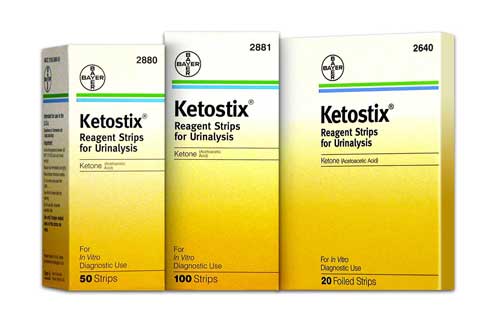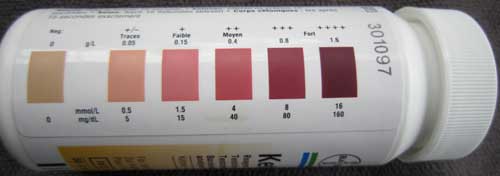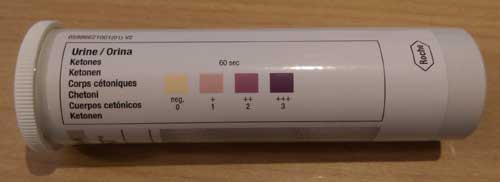
|
|
||
| Our Pages ABOUT CONSTITUTIONAL MEDICINE
|
The process of reducing dietary carbohydrates to the point that the body starts to burn fat as its primary fuel can be pivotal to rapidly curing the metabolic syndrome and/or reducing significant amounts of excess weight. Burning fat results in a person going into 'ketosis' which results in the production of measurable ketones in their urine. This article compiles some notes about how to get into, and measure, ketosis.
Firstly, if you haven't already seen it, you need to be familiar with the detailed article on the metabolic syndrome found here. Not everyone who has the metabolic syndrome needs to get into ketosis to get better or lose weight but if a person is in very poor health or has a significant amount of weight to lose then, whilst it requires a very strict approach, getting into ketosis is, by far, the best and fastest way to get positive results. You will need to completely avoid all carbohydrate-rich food. No bread, pasta, rice or potatoes whatsoever. Probably no fruit either, at least at the beginning. Anything that has any kind of flour or sugar in it, even if it purports to be a healthy food, will almost certainly contain too much carbohydrate to allow you to get into ketosis. Likewise, virtually all grains, legumes, beans etc. are going to contain too many carbs to get there. There are estimates that you have to eat 'less than 20-grams of carbohydrate in a meal' to get into, or stay in, ketosis, which is really a very small amount of carbs indeed. To help keep under that 20-gram guideline, packaged food is generally required by law to show the amount of carbohydrates on the label. For foods that do not require labelling, there are good resources on the internet that show the percentage of carbs per the weight of the food. Until you are sure, or have found the information you need, if you are trying to get into ketosis and are in doubt, you really should just leave it out. You can and should eat plenty of protein when you are on a low-carbohydrate diet but, if you are trying to get into and stay in ketosis, you need to know that if you eat over a certain amount of protein then your body will turn the excess protein back into sugar through a process called gluconeogenesis. Note that eating an excess of protein is the number one reason a person, who is eating a very low-carbohydrate diet, is still unable to get into ketosis. What 'excess-protein' means for each person will vary a lot and this is one of the key reasons that you must check yourself with the strips as described shortly. As weird and counter-intuitive as this is for anyone who has grown up in the 'fat is bad, carbs are good' mind-set of the last few decades the simple truth is that the nutritionists got this completely wrong. It is not fat that makes people overweight, or gives them metabolic diseases, it is sugar. You must eat plenty of fat to help get into, and stay in, ketosis and, in fact, this is the one food group that you can eat from as much as you like! For most people, the best way to get plenty of fat into their diet is from things like avocados, nuts & seeds, edible oils, coconut products and dairy products such as cream and cheeses. Of course, meat, fish & chicken also contain fats but, in terms of being in ketosis, you are best to eat fattier rather than leaner sources of these protein rich foods too. The body does not easily turn itself over to burning fat as its primary energy source. People who have the metabolic syndrome had ancestors who found that they had a genetic advantage from having the disposition to store excess sugar as fat in their bodies in times of famine. Even if you have stripped out carbohydrates and are not eating excess proteins, your body may still resist releasing its stored fat until you force the issue by doing some exercise. You do not have to overdo this, all you have to do is to make your body work hard enough to get your heart rate up and to keep it up for at least 10 minutes or so, though the longer the better in terms of giving your body no choice but to start plundering its fat-stores. Be assured that, once your system starts releasing fat for energy, it all gets a great deal easier. The process of getting into ketosis is rather like climbing a hill. Once a person reaches the top of the hill and gets into ketosis then things become much easier because fat is an incredibly efficient supplier of energy; weight for weight, it is four times more efficient than sugar as an energy-source! Once the fat starts being well and truly burned for day-to-day energy, people typically report feeling a great deal better, i.e. their energy levels rise, their weight levels drop, their body stops hurting and their mind stops craving carbohydrates. It usually takes at least a few days to get into ketosis and, for most people, this is the most challenging stage. Once you get started, don't fall back down the hill, but push on until those strips start changing colour, then you will know that you've passed the hardest part.
You will need special 'ketone' urine test sticks to be able to do this part, but these are readily available online. Measuring for ketosis is very straightforward, you can pee into a container and test that way, or simply hold the strip at one end and let a small amount of urine run over the other end that you're testing. The colour will change right away as soon as it has been in contact with the urine, hold it up against the colour chart on the bottle to see if you are in the pink! You should test yourself often in the early days of your program. Once you have worked out your food and exercise parameters, what keeps you in ketosis, what breaks you out of it, you won't need to test anywhere near as much. It is a mistake to focus too much on the level of ketosis you get to so long as you get there in the first place. Even if you only show trace amounts of ketones, i.e. the first level of reaction when it begins changing colour, this is still an excellent sign as there is no way you will get any kind of change unless you are actually burning fats as an energy source. Even if you are only moderately in ketosis, this is an ideal place to remain for however long is required. Being a step or two higher than the trace level will mean that you are burning more fats and will lose weight faster, but you need to know that this level will fluctuate according to the time of day, how much you are exercising and when you last ate etc. People can become preoccupied with reaching an 'optimal' level of ketosis in this area but, from clinical experience, it can be said that, so long as someone with the metabolic syndrome is in ketosis to any degree, their health should significantly improve, and their weight should rapidly drop. As mentioned in the article on the metabolic syndrome, whilst I have no financial connection to them, I recommend the excellent online support of 'Diet Dr' for anyone who wants to get into ketosis. Their website is here
Finally, you might benefit from learning about your constitution to know what kind of foods, herbs, exercises etc. will work especially well for your health in general. Constitutional health is an old and fascinating way of understanding our differences. There's a brief introduction here and a more detailed section on working out which constitution you are here.
Please understand that I cannot personally advise you without seeing you in my clinic. |
|
|
|
© 2011 R.J.Whelan Ltd



